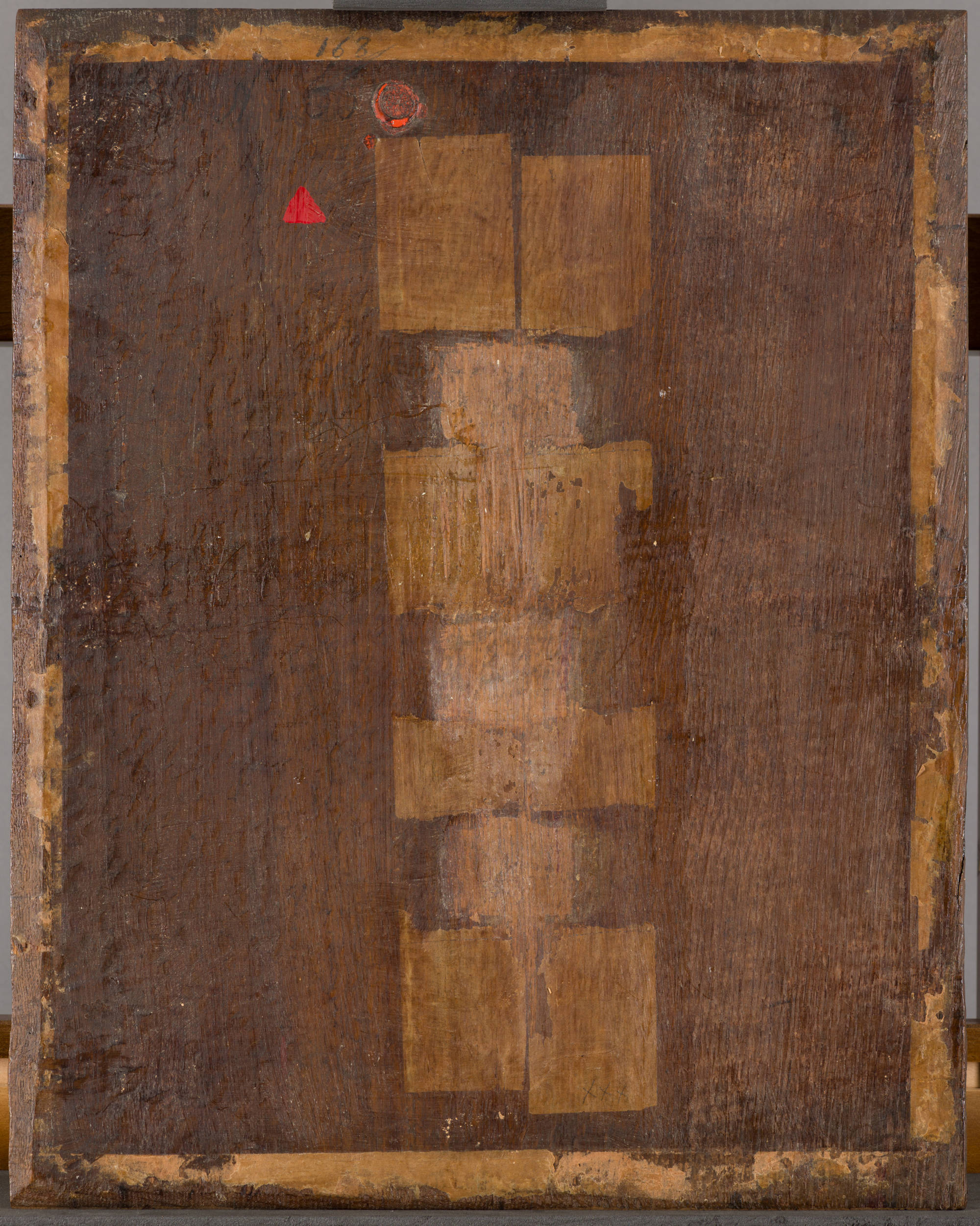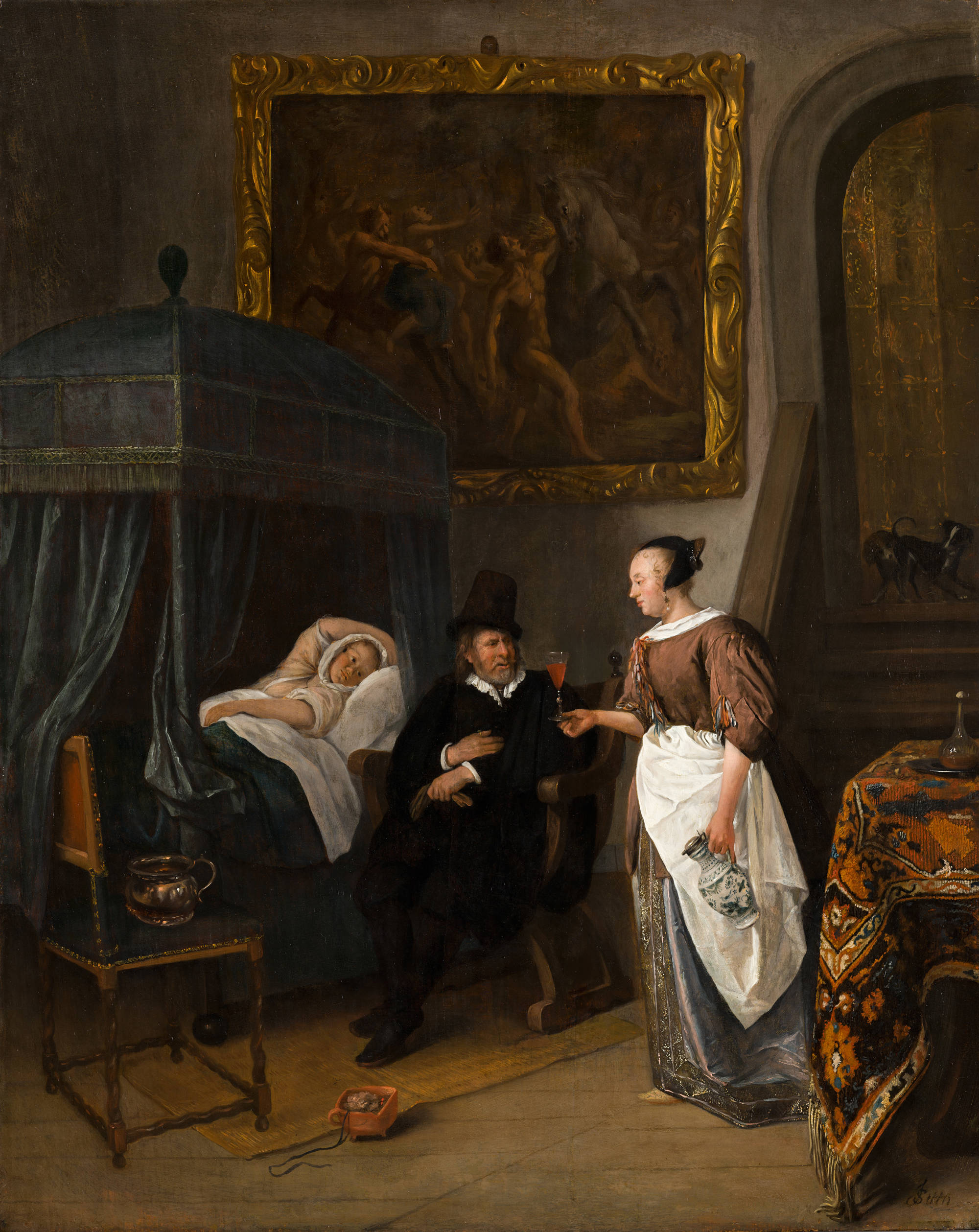A young woman sunk deep in the pillows lies in her sumptuous canopy bed. With one arm flung above her head and her bosom half bared, she turns towards the ‘doctor’, who sits by her side, holding his gloves in his hand as though he has just walked in. ‘Love fever’ (‘minnekoorts’) will no doubt be the diagnosis (cf. inv. no. 167). As always in Jan Steen’s oeuvre, the doctor is dressed in an old-fashioned costume, indicating that he is not a real physician, but a ridiculous charlatan. His attention has been diverted from the sick girl to the young woman handing him a glass of wine; if the elegant dress under her apron is anything to go by, she is merely pretending to be the maidservant. She might be bringing medicine for the patient, but it seems more likely to be wine for the doctor, who looks tipsy already with his hat perched at a precarious angle on his head.1 The full chamber pot on the chair and the flask of urine on the table refer to piskijken: the examination of urine as a diagnostic tool. The earthenware pot of coals with a burning lace is also a standard motif in Steen’s pictures of this subject (see also inv. no. 167).
In most of his ‘doctor’s visits’, Steen depicted a sick girl seated on a chair, but in approximately one-quarter of them she is lying in bed, as she is here.2 Several of these paintings are among his most sexually explicit versions, with grinning figures who make it perfectly clear that the girl can be cured only by sharing her bed with her lover. The Doctor’s Visit in the Museum Boijmans Van Beuningen in Rotterdam bears the inscription ‘Hier baet geen medesyn, want het is minnepyn’ (Remedies are tried in vain, when seeking treatment for love’s pain); here a grinning youth holds an enema, while the doctor writes a useless prescription for the bedridden patient.3 A painting by Steen in a private collection features an old woman who smirks as she hands the doctor an enema.4 The instrument is a blatant reference to sexual intercourse, for which the lovesick girl evidently yearns. In this work the bedridden patient is depicted in nearly the same pose as in the Mauritshuis painting and also wears a ‘mouche’ (a dark patch) on her temple.5 Another ‘doctor’s visit’ by Steen omits the enema, but the doctor makes a frankly obscene gesture towards the patient, who has fallen on her bed in a swoon.6 This is the only ‘doctor’s visit’ in which oysters, a well-known aphrodisiac (cf. inv. no. 818), are being prepared in the background.
Compared with the works discussed above, the present painting is more serious in tone, but the fact that the girl is lying in bed lends the scene sexual connotations that are more explicit than if she were decently dressed and sitting on a chair. The only effective remedy for the patient’s ailment is suggested by the dogs sniffing each other’s backsides at the top of the stairs at right. A painting in an auricular frame, hanging prominently on the rear wall, seems to underscore the message of this ‘doctor’s visit’. Its subject, which Steen depicted only once,7 is a fierce battle scene: in the left foreground, a centaur abducts a woman; on the right, a naked man grips a rearing horse by its mane. These motifs refer in a general way to reined-in and unbridled passion, and cannot be associated with one specific mythological story. According to Karel van Mander, for example, the centaur stood for ‘unchaste man’ and taming a horse was analogous to reason overcoming desire.8 Steen based the left half of the painting on the wall on an illustration from Ovid’s Metamorphoses by Antonio Tempesta, which portrays the Battle of the Lapiths and Centaurs.9 No doubt Steen was mainly interested in the amusing contrast between the girl, who seems to lie peacefully in her bed, and the violent emotions erupting in the painting-within-the-painting. The pictures decorating Steen’s interiors usually contain some kind of commentary on the main scene, but they are rarely as domineering a presence as the battle scene portrayed here.
Jan Steen worked out the many details in this painting meticulously
and with great feeling for the texture and appearance of the various materials: the fine Oriental carpet on the table, the brass chamber pot, the gilt auricular frame of the painting on the rear wall, the gilt-leather wall-covering in the adjacent room, the satin dress worn by the ‘maid’ and the Delftware jug in her hand, painted with an imitation Chinese decoration. This vessel strongly resembles the jug in Girl Eating Oysters (cf. inv. no. 818). The gilt picture frame appears in a number of Steen’s paintings.10 The Oriental carpet was one of his favourite motifs and a means of showing off his skill in rendering materials. He depicted a ‘Turkish’ carpet in more than sixty interior scenes and history paintings from 1660 onwards. These carpets, placed on a table or the floor, or otherwise draped to best advantage, are depicted with great attention to signs of wear and tear, such as frayed edges.11 The carpet lying on the table in The Doctor’s Visit discussed here is the one most often seen in Steen’s work. It appears, with small changes and variations in the decorative floral and geometric pattern, in at least thirty paintings. The earliest is dated 1668, though some probably originated earlier.12 Evidently he had this carpet in his possession as a studio prop. There must have been many such carpets in circulation in the Low Countries in the second half of the seventeenth century, since Gerard ter Borch, Pieter de Hooch, Jacob Ochtervelt, Richard Brakenburg and other painters depicted very similar examples.13 So far as we know, however, there is not a single surviving carpet of this type, which displays both Anatolian and Persian characteristics. The carpet, which Steen often used, might help in establishing a chronology for his work, which is seldom dated. The painting under discussion is estimated to date from the early to the late 1660s.14 As Steen used the Oriental carpet only from 1668, or perhaps slightly earlier, this work can be dated to the second half of the 1660s.15 The artist evidently took the carpet with him when he moved house for the last time in 1670, from Haarlem back to Leiden, since it appears in a painting dated 1676.16 Steen’s painter friend Frans van Mieris may have borrowed this carpet now and then, for an identical one appears in works of his that date from 1672 and 1679, both painted in Leiden.17
It is also interesting to compare this Doctor’s Visit with a variation on the same theme in the Torrie Collection in Edinburgh. That work, painted on a canvas that is slightly larger than the panel in the Mauritshuis, shows the same composition with a few adjustments and somewhat larger figures.18 The rendering of space was simplified by making the bed nearly large enough to fill the entire picture and by letting the maidservant obscure the view to the background almost entirely. These changes led to the omission of the stairs and sniffing dogs at right seen in the Mauritshuis version. Steen varied other motifs as well. For example, the table with identical carpet is placed more to the left, the chair and chamber pot are missing, and a dog has been added to the foreground. Above the doorway we see a fragment of a painting, often depicted in Steen’s doctor’s scenes, of Venus and Adonis after Tempesta.19 The room with the gilt-leather wall-covering at back right has been replaced by a distant window, at which looms the silhouette of a man, probably the sick woman’s lover. The variant in Edinburgh, based on the composition of the painting discussed here, is a simpler version of this popular scene.
Technical research has shown that someone, presumably Steen himself, had previously used the panel on which The Doctor’s Visit in the Mauritshuis was painted.20 Infrared images and X-radiographs show elements of an underlying composition. By turning the picture ninety degrees to the left, it is possible to discern an outdoor scene with a pergola, overgrown with vines, and a small building (see infrared image with drawing of the composition underneath).21








